Interview By Milene LarssonImages Courtesy of The Ingmar Bergman Foundation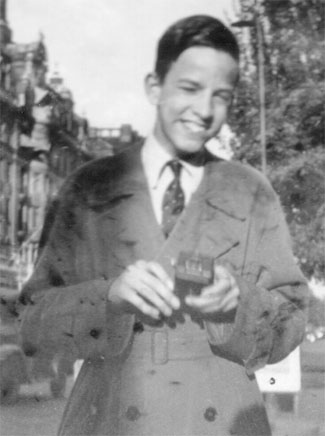 “This is a 12-year-old Ingmar with his legendary first film camera, the Laterna Magica. He used to say, ‘My life as a filmmaker begun when I got the Laterna Magica,’ and he named his autobiography after it. Apparently, it was given to his brother for Christmas and Ingmar had gotten tin soldiers but then they switched gifts.”Vice: Why did Ingmar Bergman trust you with this most private archive?What was this conversation about?He was a peeping tom!In an early notebook from ’38 you found a diary entry in which he wanted to blow his brains out. Where do you think that existential angst and self-hatred came from?Why did it take so long for Sweden to acknowledge him?Scenes from a MarriageSo you think it was, ironically, Bergman’s religious curiosity in this vastly secular country that made him world-famous?The Seventh SealYou wrote a book about all the skeletons you dug out of his closet. It must have been nerve racking giving him the manuscript.If you’re Swedish you can read more on Maaret Koskinen’s findings in her book(). Her upcoming bookwill be out later this fall. For more information about these images, visit Ingmarbergman.se
“This is a 12-year-old Ingmar with his legendary first film camera, the Laterna Magica. He used to say, ‘My life as a filmmaker begun when I got the Laterna Magica,’ and he named his autobiography after it. Apparently, it was given to his brother for Christmas and Ingmar had gotten tin soldiers but then they switched gifts.”Vice: Why did Ingmar Bergman trust you with this most private archive?What was this conversation about?He was a peeping tom!In an early notebook from ’38 you found a diary entry in which he wanted to blow his brains out. Where do you think that existential angst and self-hatred came from?Why did it take so long for Sweden to acknowledge him?Scenes from a MarriageSo you think it was, ironically, Bergman’s religious curiosity in this vastly secular country that made him world-famous?The Seventh SealYou wrote a book about all the skeletons you dug out of his closet. It must have been nerve racking giving him the manuscript.If you’re Swedish you can read more on Maaret Koskinen’s findings in her book(). Her upcoming bookwill be out later this fall. For more information about these images, visit Ingmarbergman.se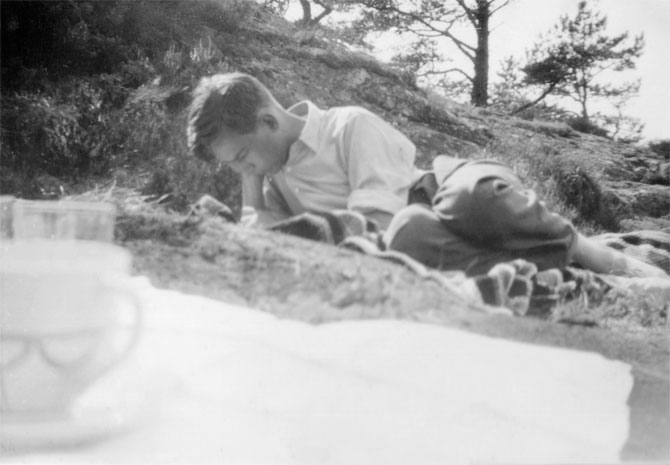 “Young Ingmar Bergman enjoying a book. He later denounced literature, claiming he was a man of the cinema when in fact he was a frustrated writer. He always said he didn’t read much but you can tell from his language that he did, and if you read his scripts they’re like novels, describing scents, people’s appearances, and ambiences—totally irrelevant information for a film script. That’s why I named my Fårö archive book In the Beginning Was the Word: It was his longing to be a respected writer that drove him. He was shocked when he read it and discovered that was actually the case. He got good at writing in the end and it must have been a sweet revenge to have the big publishing houses fight to put out his books.”
“Young Ingmar Bergman enjoying a book. He later denounced literature, claiming he was a man of the cinema when in fact he was a frustrated writer. He always said he didn’t read much but you can tell from his language that he did, and if you read his scripts they’re like novels, describing scents, people’s appearances, and ambiences—totally irrelevant information for a film script. That’s why I named my Fårö archive book In the Beginning Was the Word: It was his longing to be a respected writer that drove him. He was shocked when he read it and discovered that was actually the case. He got good at writing in the end and it must have been a sweet revenge to have the big publishing houses fight to put out his books.”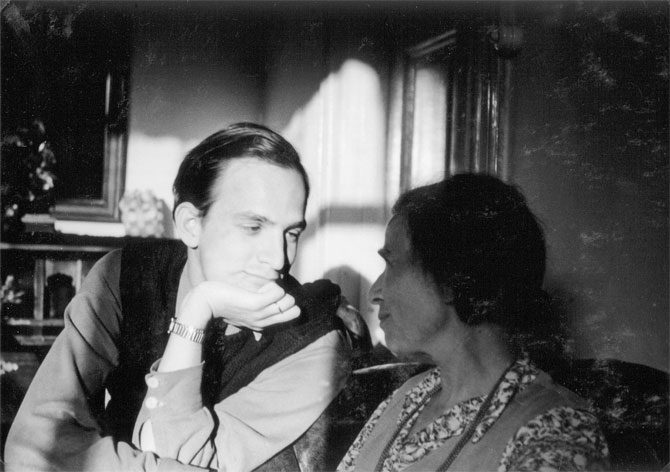 “This is Ingmar Bergman with his mother. Above all devils, girls, and whatever else was occupying his thoughts, she was dominant both in his private life and in his writing. It’s weirdly ambivalent as she sometimes turns into a desired female figure. In one of his manuscripts I found a part where a boy is looking at his mother and checking out her breasts, and it gets very strange and suggestive. After his mother passed away he found out that she had had an affair with a younger man, which laid the foundation to his films The Best Intentions and Private Confessions.”
“This is Ingmar Bergman with his mother. Above all devils, girls, and whatever else was occupying his thoughts, she was dominant both in his private life and in his writing. It’s weirdly ambivalent as she sometimes turns into a desired female figure. In one of his manuscripts I found a part where a boy is looking at his mother and checking out her breasts, and it gets very strange and suggestive. After his mother passed away he found out that she had had an affair with a younger man, which laid the foundation to his films The Best Intentions and Private Confessions.”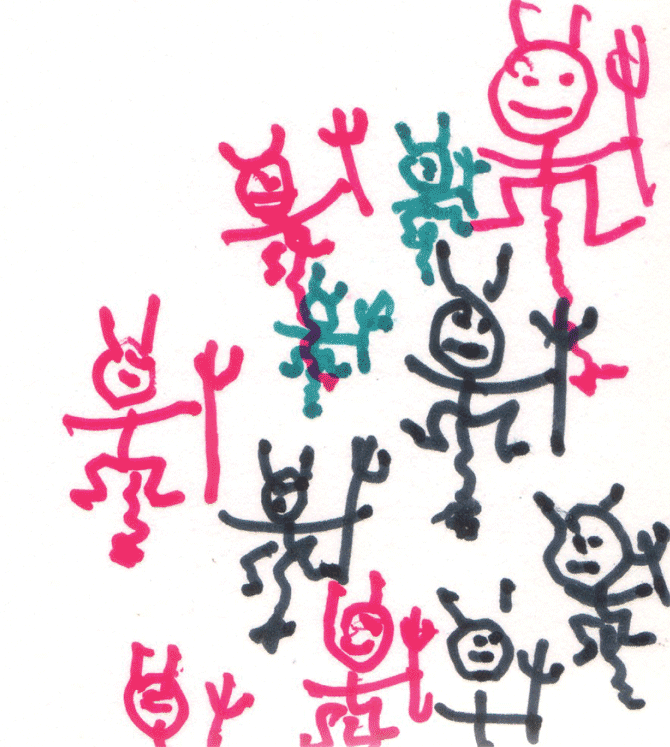 “These little devils are from one of his earliest diaries. When I stayed at his house on Fårö I found devils all over the place. He had drawn them directly on the wallpaper, the fridge, and by the lamp switches there were little devils next to the words, “Turn off the lights!” If you look at them closely they seem happy and like they’re in uprising: little rebels about to mess up the system. In most of his early 40s movies there’s a character called Jack—a sort of marionette manipulator, a young guy who is consciously causing trouble for other people. It was probably a young alter ego that Bergman identified with. He was ruthless. His wives often accused him of that and he also accused himself of being merciless in his hunt for whatever occupied him for the moment.”
“These little devils are from one of his earliest diaries. When I stayed at his house on Fårö I found devils all over the place. He had drawn them directly on the wallpaper, the fridge, and by the lamp switches there were little devils next to the words, “Turn off the lights!” If you look at them closely they seem happy and like they’re in uprising: little rebels about to mess up the system. In most of his early 40s movies there’s a character called Jack—a sort of marionette manipulator, a young guy who is consciously causing trouble for other people. It was probably a young alter ego that Bergman identified with. He was ruthless. His wives often accused him of that and he also accused himself of being merciless in his hunt for whatever occupied him for the moment.”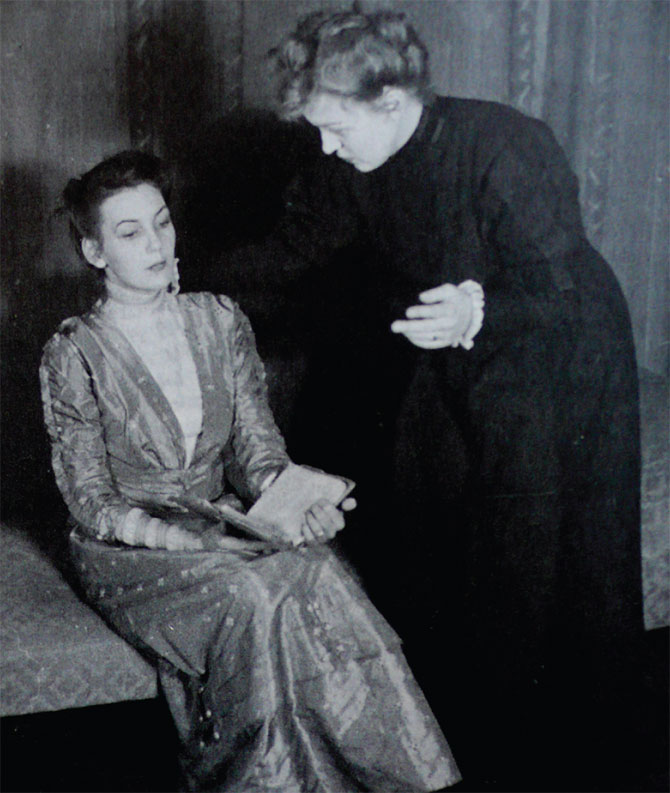 “Karin Lannby on the right was his first big love. His family didn’t approve of her so he ran away from home and didn’t come back for four years. She was a free spirit who’d taken part in founding the radical leftwing student movement in Sweden and was also a published poet with an intellectual genius who taught him a lot and was of great importance both to his personal and professional development. She became a theme in many of his early movies, like her man-eating alter ego Rut in Woman Without a Face. After breaking up with her he had his first big creative outburst, maybe in competition as she’d been both published and reviewed and was the kind of writer he wanted to match himself with.”
“Karin Lannby on the right was his first big love. His family didn’t approve of her so he ran away from home and didn’t come back for four years. She was a free spirit who’d taken part in founding the radical leftwing student movement in Sweden and was also a published poet with an intellectual genius who taught him a lot and was of great importance both to his personal and professional development. She became a theme in many of his early movies, like her man-eating alter ego Rut in Woman Without a Face. After breaking up with her he had his first big creative outburst, maybe in competition as she’d been both published and reviewed and was the kind of writer he wanted to match himself with.”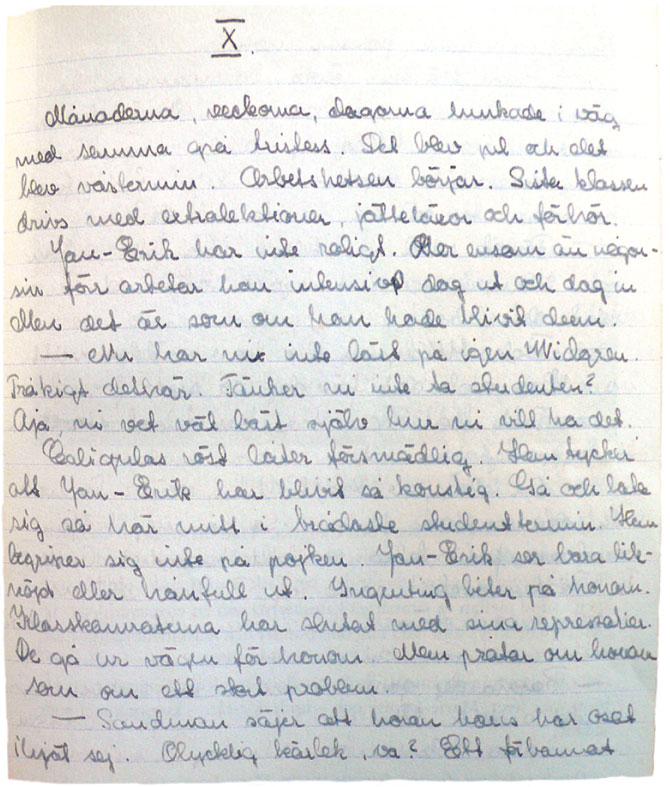 “This is an excerpt from the first draft of Frenzy, his cinematic debut in ’44. He wrote it the year after his graduation and there are all kinds of biographical details in it, like the protagonist drawing little devils, his family situation, and his life in Stockholm. If you compare it to the final manuscript for the film that came out six years later, you can see how he’s altered and censored the original script. The first version was much closer to a raw reality dealing with abortion and binge-drinking orgies when the parents were away. He washed his manuscripts in a similar way all through his career but not as visibly.”
“This is an excerpt from the first draft of Frenzy, his cinematic debut in ’44. He wrote it the year after his graduation and there are all kinds of biographical details in it, like the protagonist drawing little devils, his family situation, and his life in Stockholm. If you compare it to the final manuscript for the film that came out six years later, you can see how he’s altered and censored the original script. The first version was much closer to a raw reality dealing with abortion and binge-drinking orgies when the parents were away. He washed his manuscripts in a similar way all through his career but not as visibly.”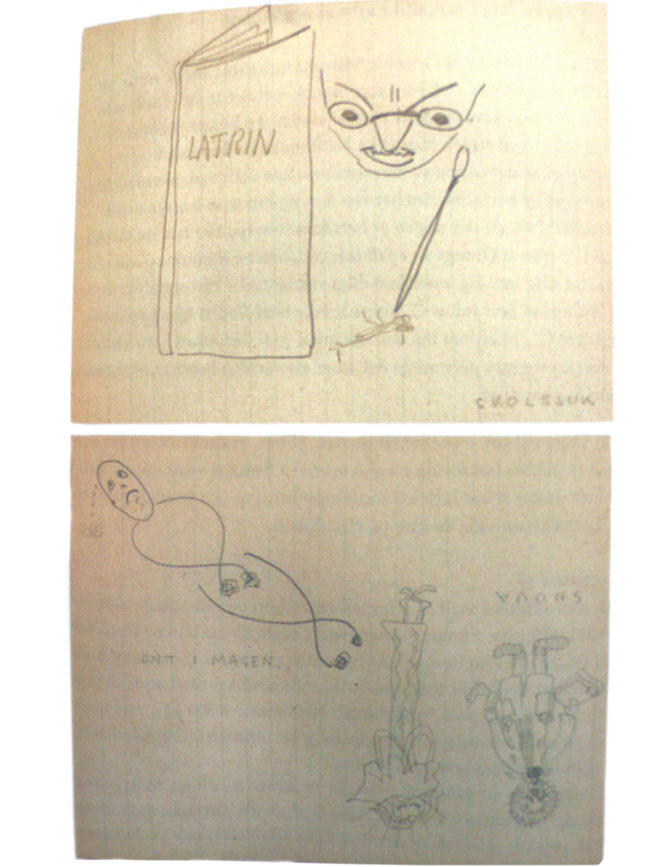 “These drawings accompanied the first Frenzy draft, in which he looked back at the school experience as being in a fascistic hierarchic system. “Latrin” means lavatory and outside of it lays a poor, dehydrated student with that terrible teacher’s face looking down and pointing his stick at him. “Skolsjuk” and “ont i magen” means school sick and stomach ache—Bergman famously suffered from stomach aches due to angst throughout his life. His mother’s diaries and his mentors’ notes all say he was the teacher’s pet, which doesn’t mean that he didn’t indeed hate school, and like most young men at that time he wanted to be seen as a rebel that went against the system.”
“These drawings accompanied the first Frenzy draft, in which he looked back at the school experience as being in a fascistic hierarchic system. “Latrin” means lavatory and outside of it lays a poor, dehydrated student with that terrible teacher’s face looking down and pointing his stick at him. “Skolsjuk” and “ont i magen” means school sick and stomach ache—Bergman famously suffered from stomach aches due to angst throughout his life. His mother’s diaries and his mentors’ notes all say he was the teacher’s pet, which doesn’t mean that he didn’t indeed hate school, and like most young men at that time he wanted to be seen as a rebel that went against the system.”

ΔΙΑΦΗΜΙΣΗ

ΔΙΑΦΗΜΙΣΗ





